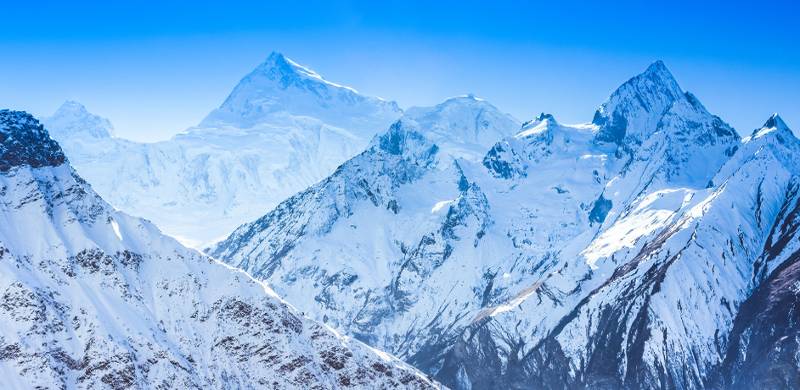
James Temple in the MIT Technology Review explains the accelerated melting of the Himalayan glaciers. He went on to quote recent studies regarding the matter.
Temple serves as the senior editor at the MIT Technology review and focuses on climate change mainly.
Temple quotes a paper published in Science Advances, "Acceleration of ice loss across the Himalayas over the past 40 years" where researchers from Columbia University and Universit of Utah studied declassified satellite images. The researchers concluded that the Third Pole is now melting twice as it was before.
Third Pole is primarily the region that encompasses Himalayan, Hindu Kush ranges and the Tibetan Plateau. It is known to have the largest freshwater reserve outside the polar regions.
Although the data has been obtained from US spy satellites in the past, it was modeled by scientists to be compared with modern satellite images. The study itself is the first of its kind where the four-decade record of ice has been captured along the 2000km mountain stretch.
The research comprised of data back from the mid-1970s to 2000s compared with data from 2000 to 2016. According to the researchers from 2000 to 2016, glaciers in the Himalayan region have lost an almost vertical foot and half of the ice each year. This stands out to be far greater than the earlier portion of the study.
The article quotes another Landmark report which claims that 15% of the glaciers in the region ( Hindu Kush) have already melted while the remaining two-thirds might disappear by the end of the century. The prediction is based on the prevalent level of greenhouse gas emission.
It is important to note here that the Himalayan glaciers are the largest stockpile ice outside the North and the South pole. The melting glaciers act as a waterway for Asia including River Ganges, Indus, Yangtze and Yellow rivers as published by China Water Risk.
Although the impact of acceleration is a threat to the world, it is far more devastating for a billion or more inhabitants of the region down the Himalayas.
Temple concludes the article on a worrying note regarding the accelerated melting of Himalayan Glaciers. He quotes one of his earlier pieces regarding India`s water challenges.
“Initially the increased runoff will swell rivers, raising the risks of downstream flooding but sending Indians more water. That trend is likely to shift into reverse in the second half of the century, however, shrinking the flow to around 1.9 billion people who live along those rivers. The Ganges basin alone supports 600 million people, provides 12% of the country’s surface water, and accounts for 33% of GDP.”
Temple serves as the senior editor at the MIT Technology review and focuses on climate change mainly.
Temple quotes a paper published in Science Advances, "Acceleration of ice loss across the Himalayas over the past 40 years" where researchers from Columbia University and Universit of Utah studied declassified satellite images. The researchers concluded that the Third Pole is now melting twice as it was before.
Third Pole is primarily the region that encompasses Himalayan, Hindu Kush ranges and the Tibetan Plateau. It is known to have the largest freshwater reserve outside the polar regions.
Although the data has been obtained from US spy satellites in the past, it was modeled by scientists to be compared with modern satellite images. The study itself is the first of its kind where the four-decade record of ice has been captured along the 2000km mountain stretch.
The research comprised of data back from the mid-1970s to 2000s compared with data from 2000 to 2016. According to the researchers from 2000 to 2016, glaciers in the Himalayan region have lost an almost vertical foot and half of the ice each year. This stands out to be far greater than the earlier portion of the study.
The article quotes another Landmark report which claims that 15% of the glaciers in the region ( Hindu Kush) have already melted while the remaining two-thirds might disappear by the end of the century. The prediction is based on the prevalent level of greenhouse gas emission.
It is important to note here that the Himalayan glaciers are the largest stockpile ice outside the North and the South pole. The melting glaciers act as a waterway for Asia including River Ganges, Indus, Yangtze and Yellow rivers as published by China Water Risk.
Although the impact of acceleration is a threat to the world, it is far more devastating for a billion or more inhabitants of the region down the Himalayas.
Temple concludes the article on a worrying note regarding the accelerated melting of Himalayan Glaciers. He quotes one of his earlier pieces regarding India`s water challenges.
“Initially the increased runoff will swell rivers, raising the risks of downstream flooding but sending Indians more water. That trend is likely to shift into reverse in the second half of the century, however, shrinking the flow to around 1.9 billion people who live along those rivers. The Ganges basin alone supports 600 million people, provides 12% of the country’s surface water, and accounts for 33% of GDP.”
